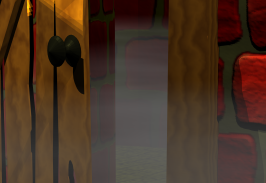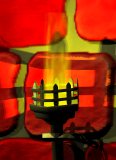Integrated Intesity Volume Rendering
The ordinary ray tracing procedure assumes that each ray is flying through a vacuum. If you want to change this, e.g. for rendering some fog that influences the ray, one has to take special effort.
by Steffen Lösch and Nikolai Knopp
The ordinary ray tracing procedure assumes that each ray is flying through a vacuum. If you want to change this, e.g. for rendering some fog that influences the ray, one has to take special effort.
In the scene you can see some fog on the whole ground up to some height. The fog is best visible behind the door. It is not just homogeneous, but varies in space.

If you take a close look at the torches, you can observe that their flames are actually modelled by a dense and yellow volume with exponentially decreasing thickness.

The volume is simulated by a 3-d grid that lies somewhere in the scene and contains some volume densities. When a ray flies through this 3-d grid it is sampled in an equidistant way and the densities along its way are added. The density of a single point in the 3-d grid is determined by trilinear interpolation.